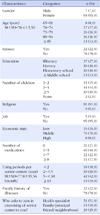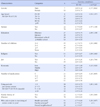Abstract
Purpose
The purposes of this study were to examine the relationship between health belief and exercise compliance among elderly adults at senior centers and to identify factors influencing their exercise compliance.
Methods
The subjects of this study were 100 elderly adults who were using senior centers in J City. Data were collected from the 5th of August to the 14th of September in 2014 using a questionnaire about general characteristics, health belief, and exercise compliance. Data analysis included one-way ANOVA, independent t-test, Pearson's correlation, and stepwise multiple regression using the SPSS/WIN 18.0 program.
Results
The mean score for exercise compliance was 3.85 (range 1~5), and for perceived health state 3.17 (range 1~5). The mean score for each of the sub-factors of health belief was 3.89 for benefit, 1.94 for barrier, 3.34 for severity, 2.43 for sensitivity, and 3.65 for exercise self-efficacy (range 1~5). There was a significant correlation between exercise compliance and exercise benefit, and 28% of variance in exercise compliance was explained by exercise benefit in health belief, family history of illnesses, and perceived sensitivity in health belief.
Figures and Tables
Table 1
General Characteristics of Subjects (N=100)

Table 2
The Degree of Research Variables in Subjects (N=100)

Table 3
The Differences of the Exercise Compliance according to General Characteristics of Subjects

Table 4
Correlation between Exercise Compliance and Other Variables in Subjects (N=100)

References
1. Statistics Korea. 2012 life tables for Korea [Internet]. Seoul: Statistics Korea;2012. cited 2012 September 27. Available from: http://kostat.go.kr/portal/korea/kor_nw/2/6/1/index.board?bmode=read&aSeq=260368.
2. Jeong GH, Oh YH, Lee YG, Son CG, Park BM, Lee SY, et al. 2011 senior survey. Policy Report. Seoul: Ministry of health and Welfare & Korea Institute for Health and Social Affairs;2012. 04. Report No.: 11-1352000-000672-12.
3. Kim DO, Yun SN. An exploratory study of factors associated with the health behavior of working elderly with chronic diseases. J Korean Acad Community Health Nurs. 2012; 23(4):395–404.

4. Kim BR, Kang SJ, Chung SL, Lee DK. Effect of aerobic exercise on the hemodynamic predictors of the hypertensive patient. Off J Korean Assoc Certif Exerc Prof. 2008; 10(2):19–25.
5. Choi ES. The metabolic syndrome and associated risk factors among male workers in an electronics manufacturing company. Korean J Occup Environ Med. 2006; 18(1):35–45.

6. Kim TH, Kim SS, Hang YS, Shin MS, Chung YR, Kang JY. The effects of 12 weeks exercise program on superoxide dismutase and malondialdehyde of non-insulin dependent diabetes mellitus (NIDDM) patients. J Coaching Dev. 2005; 7(4):217–224.
7. Bak HK. A study on leisure activities, leisure life satisfaction, perceived health status and depression in the elderly. Korean J Rehabil Nurs. 2009; 12(2):112–119.
8. Eun Y, Gu MO, Kim ES, Kang YS. A comparative study of the health state and need of health-related service between elderly attending the senior welfare center and elderly attending the senior citizens' club. J Korean Gerontol Nurs. 2001; 3(1):7–21.
9. Kim HJ, Chae SO, Park YS, Woo SH. The relationship between perceived health state, health conception and health promoting behavior in the elderly. J Korea Community Health Nurs Acad Soc. 2001; 15(2):262–274.
10. Rosenstock IM, Strecher VJ, Becker MH. Social learning theory and the health belief model. Health Educ Q. 1988; 15(2):175–183.

11. Yang SJ, Jang SH, Kim SJ. Physical activities and health belief of elementary school students for obesity prevention and management among elementary school students. J Korean Acad Public Health Nurs. 2012; 26(2):227–238. DOI: 10.5932/JKPHN.2012.26.2.227.

12. Byun YH, Choi KS. A study on health beliefs and range of motion exercise of impaired physical mobility patients in lower extremity. Chung-Ang J Nurs. 2002; 6(1):55–60.
13. Kim YH, Park SG, Lee HS. The effect of the people with physical impairments health belief on exercise behavior. Educ J Phys Mult Disabl. 2012; 55(2):75–97.
14. Choi C, Park J, Kang MG, Kim KS. The association between performance of hepatitis B vaccination and health belief factors among some aged persons. Korean J Health Educ Promot. 2006; 23(4):89–104.
15. Wang MJ, Cha NH. A study on health belief and health behaviors of the elderly. J East West Nurs Res. 2003; 8(1):103–112.
16. Marcus BH, Selby VC, Niaura RS, Rossi JS. Self-efficacy and the stages of exercise behavior change. Res Q Exerc Sport. 1992; 63(1):60–66.

17. Hwang EH, Chung YS. Effects of the exercise self-efficacy and exercise benefits/barriers on doing regular exercise of the elderly. J Korean Acad Nurs. 2008; 38(3):428–436.

18. Kim SY, Oh CO. Evaluation and needs of the elderly for spatial characteristics of senior centers in apartment complex. Korean Inst Inter Des J. 2013; 22(5):33–41.

19. Lee YK. Policy suggestions for the improvement of welfare leisure centers in Korea. Health Welf Policy Forum. 2013; 198:56–66.
20. World Health Organization. 2011 physical activity and adult [Internet]. Geneva: World Health Organization;2011. cited 2015 January. Available from: http://www.who.int/dietphysicalactivity/factsheet_adults/en/.
21. Yun YJ. (The) model explaining variance in health promoting behavior and quality of life in women with osteoporosis [dissertation]. Seoul: Kyung Hee University;2001. 142.
22. Lawston MP, Moss M, Fulcomer M, Kleban MH. A research and service oriented multilevel assessment instrumen. J Gerontol. 1982; 37(1):91–99.
23. Hwang MH. A model of self-care and well being of elderly [dissertation]. Daegu: Kyungpook National University;2000. 106.
24. Lee JY, Seo BH, Kang SK. Development of exercise participation - measurement tool using health belief model. Korean Soc Meas Eval Phys Edu Sports Sci. 2012; 14(2):51–60.
25. Lee PS, Jang SO. The study on the effect of stage based exercise motivational intervention program for the elderly. J Korean Acad Nurs. 2001; 31(5):818–834.

26. Ko YJ, Lee JH. Factors influencing exercise compliance among older adult. J Muscle Joint Health. 2012; 19(2):223–232.
27. Shin YH, Jang HJ. Perceived exercise self-efficacy and exercise benefits/barriers of Korean adults with chronic diseases. J Korean Acad Nurs. 2000; 30(4):869–879.

28. Cho SR, Cho HI, So YH. The influence of health belief on quality of sleep and happiness index according to exercise participation in middle-aged women. J Korean Phys Edu Assoc Girls Women. 2013; 27(1):45–61.
29. Song R, Jung KJ, Ro YJ, Kim CG. Effects of motivation-enhancing program on health behaviors, cardiovascular Risk factors, and functional status for institutionalized elderly women. J Korean Acad Nurs. 2001; 31(5):858–870.

30. Kim MK, Choi SM. The effect of the regular dance sports program on physiological function, mental health and perceived health state in older women. J Coaching Dev. 2004; 6(3):281–290.




 PDF
PDF ePub
ePub Citation
Citation Print
Print



 XML Download
XML Download